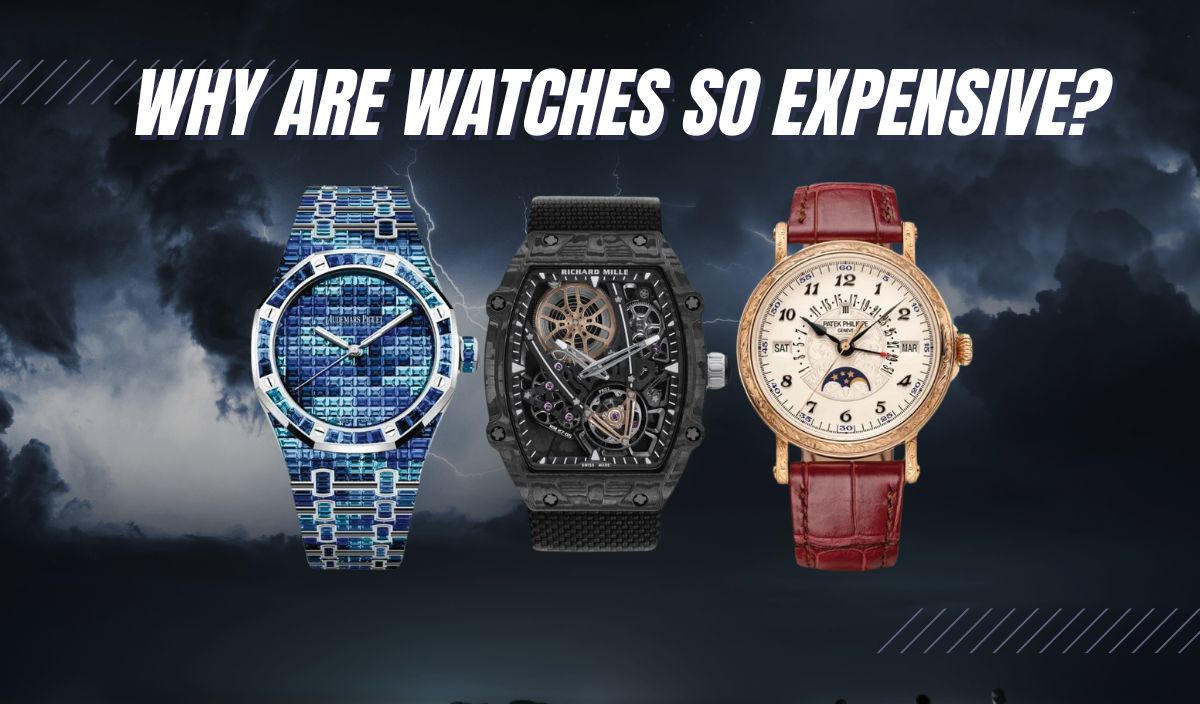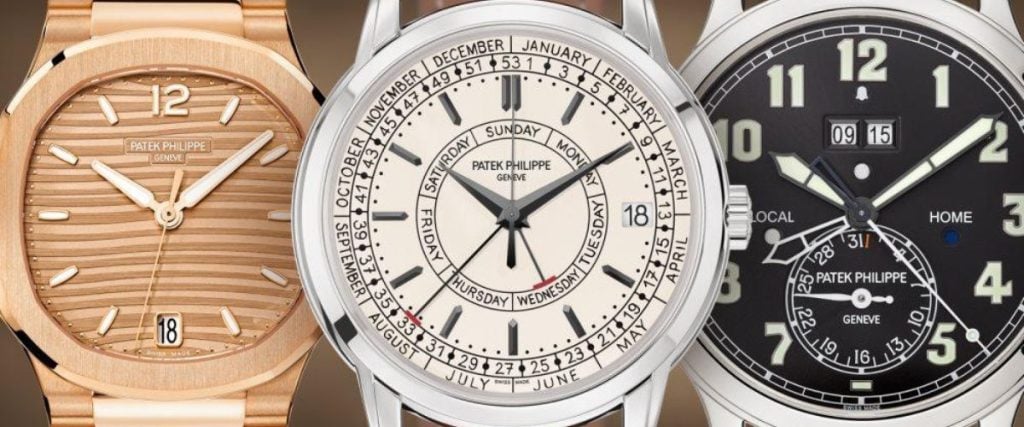
Why Are Watches So Expensive?
Unless you’re a bit of a watch snob, you’ll agree when I say there are fantastic watches to be had at all price points across the market. If we’re being completely honest here, a great deal of those sitting in the affordable sector don’t get half the recognition they deserve. Some watches below the $1k mark can keep better time than those costing just short of $30k.
If you’re a true connoisseur, you’ll have the ability to appreciate the beauty found in all classes of watches. It’s a little like being an artist or an aesthete. To interpret a piece of art, one must appreciate that beauty comes in many forms, and what is a work of art to one may not be to another’s taste. Watchmaking is similar.
There are many interpretations of the wristwatch, and while some may argue that the Rolex Daytona is overpriced, others will pay an arm and a leg for one.
From the cheap and cheerful Casio of the watch world to the highly coveted Patek Philippe Nautilus or the AP Royal Oak – one thing is for sure. Beauty is in the eye of the beholder. But this doesn’t explain the reason behind one frequently pondered question. Why are some watches so expensive?
To answer this question, we need to explore several factors in a considerable level of detail. We should look at manufacturing techniques, materials, brand provenance, exclusivity, and how supply versus demand impacts the desirability of a watch and how highly that brand is regarded.
Looking at all these elements will provide solid answers to some burning questions you may have before setting out on your watch-collecting journey. But more importantly, by the time you reach the end of this article, you’ll have formed some sort of an opinion on whether expensive watches are really worth it. After all, can you really put a price on horological love?
Let’s dig in deep and look at some factors that determine the price of a luxury watch and why.

Are Watches Really That Expensive?
I mean, it’s a debate that could last all day. Like anything in life, the price spectrum for watches, both the luxury and designer kind, is huge. And how do you even define what “expensive” is anyway? Doesn’t it depend on who you ask?
One person could spend $100k on a classic sports car and only take it for a spin twice a year. To him, that car is worth its weight in gold because it’s been his ultimate dream since the age of 10. Ask him what he’s willing to spend on a watch, however, and you may get a very different answer depending on whether watches are his passion or just a practical necessity.
The truth is, if you’re not a watch person, you won’t want to spend good money on one. In that same vein, if your grail watch just so happens to be an expensive Rolex or Patek, you’re going to jump through hoops to find the money for one. You’ll make it work because whatever the cost, it’s a small price to pay for happiness.
But let’s keep it real. For the majority of us enthusiasts, premium, high-end, luxury timepieces aren’t a daily purchase, and we often need to consider how much we can and want to spend on one before splashing out.
What Makes Luxury Watches So Expensive
Big watches mean big bucks. What I mean by that is if you want to wear an industry-respected name on your wrist, it’s going to cost you. Money doesn’t just grow on trees, either, so understanding what makes a watch expensive will help you factor in everything you need before taking the plunge. Here are a few reasons why some watches are so costly.
Research and Development
Technology like Montblanc’s Summit, Hublot’s Big Bang Tourbillon, and TAG Heuer’s lab-grown diamonds don’t just appear overnight. It takes many leading brands in the industry years to innovate new design concepts.
Manufacturers like Rolex produce their own in-house case materials, while British brand Bremont opened up a 5,000 sq ft state-of-the-art Manufacturing & Technology Centre just a couple of years ago. The facilities act as a museum, a workshop, and a research center for trialing new concepts.
Aside from the amount of time it takes a brand to produce a watch, R&D also greatly determines the expense of a watch. The more advanced watchmaking becomes, the more the collector expects it.
Watchmakers spend millions of dollars a year on perfecting new manufacturing techniques to keep watches exciting and interesting. New movements, new materials, and improving staff training are just some of the ways they may need to invest their money.
It’s also worth noting that brands will have more than one project on the go. Sometimes watch movements can take several years to develop, and not all will be successful. Whether a hit or not, these costs all need to be worked into the price of the company’s watches.
Working With In-House Components
Quite often, budget brands and micro brands aiming their designs at smaller audiences will keep their costs down by outsourcing their watch components. This means that anything from a movement to a case or even a set of dial hands can be sourced from third parties. It’s not uncommon for brands to source components from Asia or have their watches assembled in China, either.
ETA and Miyota movements are often outfitted in affordable watches. You may also recognize the name Sellita being used when researching the movement inside a watch. In other cases, brands may modify a mainstream movement and re-label it.
While there is plenty of snobbery surrounding the topic of in-house movements being more reliable than mainstream movements, there is a reason why Sellita and ETA movements have been around for donkey’s years. They are tried-and-tested movements renowned for their reliability and precision.
Of course, there is no guarantee that in-house components like case materials and movements are going to perform better than third-party components. However, some collectors prefer a vertically integrated company. I guess it’s the reassurance that one brand is solely responsible for the design, manufacture, and assembly of those components. Potentially, this means that there is only one place to go to get a service or repair carried out. But in some ways, this serves to make a watch feel more exclusive and elite.
The Handcrafted Touch
Craftsmanship gets expensive very quickly. As you move further into the luxury realm of timekeeping, you see less machine work. The skilled labor behind the making of a watch is lengthy and meticulous. Many watchmakers working for a reputable company undergo years of training to reach the level at which they can be considered skilled craftsmen of Haute Horlogerie.
There’s probably a lot less science involved in watchmaking than you think. To become a true artisan, watchmaking becomes more intuitive than anything else. There’s a ton of skill behind an expensive watch. In this line of work, even the tiniest of imperfections can ruin a design.
The decorative side of watchmaking is just as impressive. Time-honored techniques and traditions are learned at the bench and, sometimes, take decades to perfect. Elaborate engravings, chamfering, and engine-turned dials are what you pay for and expect to see in a high-end watch.
Dial & Case Finishing
Similar to the topic of craftsmanship, the finishing on a dial and case is one way of highlighting the exponential difference between a budget watch and a high-end timepiece. Surprisingly, the case material itself rarely reflects in the cost of a watch.
Moreover, it is the care and attention that goes into it that does. Take the steel sports watch as an example. The integrated bracelet design is a highly coveted one that, despite being made from a more affordable material, can sell for a much higher price than its gold counterpart.
Another example is Rado. The Swiss brand produces its own high-tech ceramic. The product is incredibly difficult and expensive to produce, and the brand does it all in-house, yet they’re still very reasonably priced.
On the other hand, a ceramic watch by Audemars Piguet can run you up a staggering $98k! But Audemars Piguet is considered part of the Holy Trinity in horology, alongside Vacheron Constantin and Patek Philippe – two other expensive watch brands – so go figure!
The complexity of case finishing across the market varies massively, and this, in turn, reflects in the price of a watch. A perfectly round and polished case is much easier to produce than a case with compound curves, executed in a mix of brushed and polished surfaces.
A lot of these finishes are still done by hand. Even a degree of inconsistency associated with hand finishing adds character to a watch. Collectors often favor (and will pay a high price for) artisan handwork over machined perfection.
Guilloche dials, hand-painted enamel displays, and signature dial patterns on a watch face also reflect a high price tag. The engine-turned dials you see in a Breguet watch, for example, are praised and celebrated amongst watch connoisseurs. And the Tapisserie dial of an AP watch is rooted in tradition, just like Clous de Paris (or hobnail) dials are synonymous with watches like the Calatrava from Patek Philippe.
The Importance of Attention to Detail
Similar to the finish in a case or on a dial, meticulous finishes demand a higher price and reflect a higher level of work. Attention to detail in a watch showcases a level of artistry and complexity that you simply can’t find in a budget watch.
The dedication involved in creating a unique timepiece, bound by a learned skill, naturally imbues a watch with intrinsic value. For many collectors, appreciating the meticulous finishes in a watch is all part of the appeal of acquiring these coveted items.
Wearing a Status Symbol
Luxury watches are sometimes viewed as a symbol of status and wealth. To a great degree, they’re an extension of the wearer’s personality. Being a watch enthusiast myself, I often look at what a person is wearing on his wrist.
Call me “judgy”, and I certainly wouldn’t recommend this method to determine whether someone is a good human or not, but I like to think it’s a horophile’s way of instinctively sniffing out someone with equally good taste.
Also, historically, watches have always been an indication of someone’s wealth. When you’ve experienced any level of success in life, the natural thing to want to do is buy a product that reflects it in some way.
While some investments can be flashy, a watch is a rather understated way to show the world you’re doing well in life. More importantly, though, they’re an expression of a person’s identity.
What may be an impulsive buy for someone with plenty of cash to splash may be a careful and considered purchase for another. Either way, wearing a status symbol comes at a price, and part of the enjoyment of owning one is reaching the milestone at which you can become an owner of a truly coveted timepiece.
The Exclusivity Factor
The price of a watch can increase when you pay for a revered name. More often than not, this element goes hand-in-hand with wearing a status symbol – something that is vastly recognized as a coveted timepiece.
Some of the most collectible timepieces are the rarest and most expensive and come with a high price tag. Worn by those in niche watch-collecting circles, the Patek Philippe fans and Vacheron Constantin enthusiasts of the world enjoy the feel of exclusivity that an expensive watch brings.
Micro brands, to an extent, can also offer this experience. What many don’t realize is that lots of micro brands largely make up their watches with catalog parts. Cases, dials, bracelets, end links, clasps, hands, indices, and crowns are taken off the shelf and custom-made, allowing wearers a level of control over the customization element of their watch.
While the parts themselves are not “exclusive” in the grand scheme of things, a collector can enjoy a watch produced to his spec by paying for the design and tooling of a watch over buying a finished design.
Next, I’ll talk about supply and how low quantities of a watch can feed into the exclusivity factor and its desirability among enthusiasts. But it’s important to acknowledge that a lot of the time, it’s a culmination of several factors bound together in a watch design that makes it so expensive.
Supply Vs Demand
One of the contributing factors that make watches so expensive is the quantity of the product, how long it takes to manufacture, and how many collectors demand it. These three factors are all inextricably linked.
The imbalance of supply vs demand leads to an increase in the desirability of a watch. Ridiculous waiting lists can rack up as brands try to manage the supply of watches to customers. It also gives a company more scope to increase prices. Those who manage to acquire a long-awaited timepiece may sell it for a much higher price to a collector who is happy to pay it.
Explore the
Biggest Pre-Owned Collection of Luxury Watches
Some watches are more in demand than others, which highlights the importance of resale value on the pre-owned market later down the line. Some investment-worthy timepieces appreciate in value as time goes on. Others lose value.
Resale will always fluctuate, but generally speaking, iconic watches produced in small batches or limited edition quantities sell for a higher price on the secondary market than their initial retail price.
The Impact of Marketing Costs
The story behind a brand and its provenance pays for itself in terms of marketing. If a watchmaker has an intriguing and revered history, the watches sell themselves. After all, timepieces are symbols of ingenuity and a testament to the relentless pursuit of horological beauty. Standing the test of time throughout the years and surviving turbulent historical landmarks like the Quartz Crisis, for example, goes a long way in securing a solid fan base.
All brands want to sell their watches. Typically, some will sponsor prestigious events that reflect their values in a particular field, be that business, sports, or diving. Some examples may include football championships, tennis tournaments, or Formula 1 and yachting teams. Companies like TAG Heuer and Breitling put particular focus on having a family of brand ambassadors that promote and sell “the lifestyle”.
Marketing is often the final step in the watchmaking chain, but it’s an important one. Since brands need to factor the costs of marketing into their products, we are inevitably paying for the advert that made us buy it in the first place.
Should You Buy an Expensive Watch?
When it comes to expensive watches, the proof is in the pudding. You either feel strongly about luxury watches and their meticulous craftsmanship and beauty, or you don’t. The majority of passionate collectors share the same opinion – that they are worth every penny.
Expensive timepieces and horological innovation go hand-in-hand. These beautiful instruments are works of art and mechanical masterpieces all rolled into one.
Being able to appreciate the intricacies of a timepiece by flipping it over and admiring the working movement is not a learned skill. Moreover, it’s an innate, deep-seated affection for timekeeping and the desire to keep the tradition of this craft alive.
Those who appreciate the complexities of crafting an authentic watch and the time and skill it takes to complete one will share the opinion that expensive watches are certainly worth it.
Wrapping Up
A watch does not instantly become expensive the moment you move from a quartz battery to a mechanical movement. There are so many other factors at play that control and determine the price of a watch.
Sometimes, there are more obvious signs as to why you’d pay more for one luxury watch over another. Brand name and provenance, along with materials, are just a few examples.
Other factors are more subtle, but when you reach the stage in your watch-collecting journey where you can look deeper into a design and appreciate these small details, the price-to-value logic becomes more of a rational thing.
About Exquisite Timepieces
Established in 1998, Exquisite Timepieces is your one-stop shop for all things luxury watches! We are an authorized dealer for 60+ luxury watch brands including Omega, Hublot, Seiko, & Longines! We are proud to showcase one of the world’s largest pre-owned watch collections, including renowned brands like Rolex and Patek Philippe. Check out our brand new watch arrivals here and popular pre-owned listings here.



















